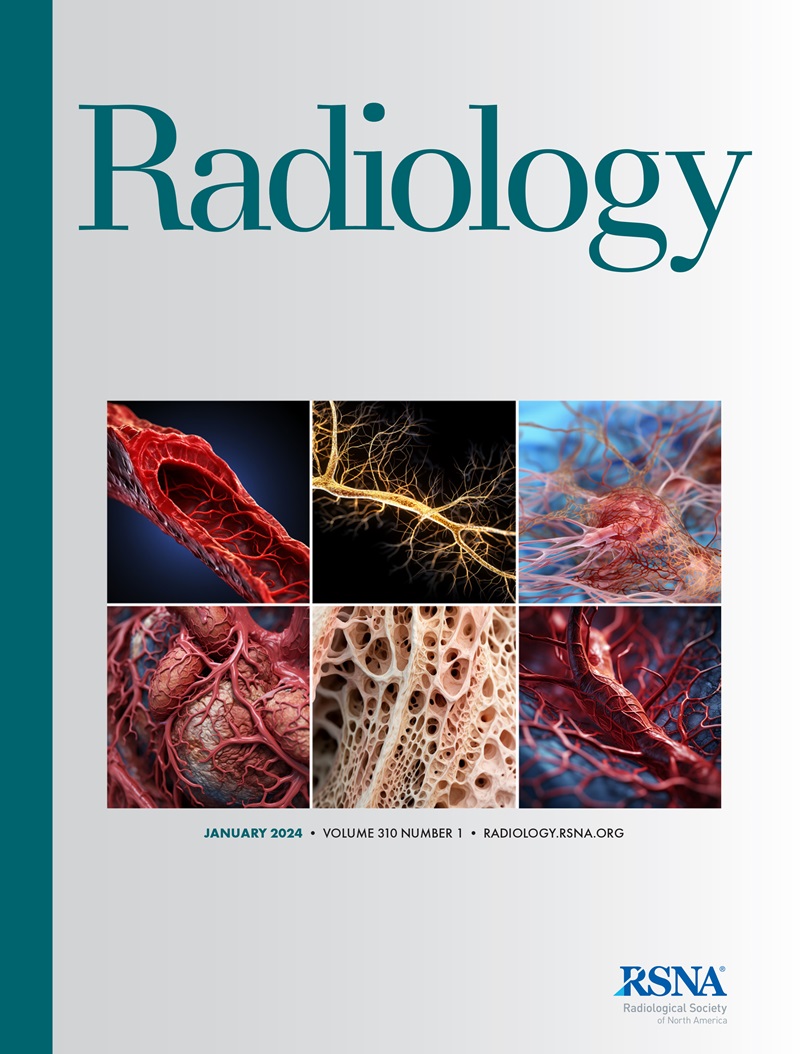胎儿脑氧合和容量对先天性心脏病脑成熟和神经发育结局的影响。
IF 15.2
1区 医学
Q1 RADIOLOGY, NUCLEAR MEDICINE & MEDICAL IMAGING
引用次数: 0
摘要
背景:神经发育迟缓是先天性心脏病(CHD)长期发病的原因之一。关于胎儿期对后期神经发育影响的数据有限。目的探讨胎儿脑氧合和脑容量受损对围产儿脑成熟和早期神经发育结局的影响。材料和方法在这项单中心前瞻性研究(2017年4月至2024年11月)的二级分析中,患有冠心病的胎儿和正常胎儿在妊娠晚期接受了带有T2*定位的胎儿脑MRI来评估氧合。冠心病患者在30个月大时接受新生儿MRI检查,并使用Bayley婴幼儿发育量表进行神经发育测试。T2*和脑容量按性别和胎龄与对照组比较,产生残差。采用单变量和多变量线性回归模型评估胎儿到新生儿MRI的脑容量生长率、新生儿白质(WM)表观扩散系数和分数各向异性以及30月龄神经发育与残余胎儿T2*和残余胎儿脑容量的关系。结果本研究纳入80例个体(胎脑MRI平均胎龄34.0周±0.9 [SD];男性胎儿52例;冠心病胎儿60例,对照组20例)。没有证据表明胎儿T2*与围产期脑生长率(β = 0.06 [95% CI: -0.00, 0.12]; P = 0.06)、WM表观扩散系数(P = 0.11)、WM分数各向异性(P = 0.21)或30个月神经发育(运动,P = 0.99;语言,P = 0.89;认知,P = 0.99)相关。在多变量分析中,与大动脉转位相比,单心室生理学与更差的运动评分相关(β = -19.87 [95% CI: -39.61, -0.13]; P = 0.049),而胎儿剩余脑容量与语言评分呈正相关(β = 0.79 [95% CI: 0.05, 1.54]; P = 0.04)。结论胎儿脑氧合与围产期脑成熟或早期神经发育结局无关,但胎儿脑容量和病变复杂性(以病变类型为代表)分别与语言改善和运动预后恶化有关。©RSNA, 2025本文可获得补充材料。本文章由计算机程序翻译,如有差异,请以英文原文为准。
Effect of Fetal Brain Oxygenation and Volume on Brain Maturation and Neurodevelopmental Outcomes in Congenital Heart Disease.
Background Neurodevelopmental delay is a cause of long-term morbidity in congenital heart disease (CHD). There are limited data on the effects of the fetal period on later neurodevelopment. Purpose To assess the effect of impaired fetal brain oxygenation and fetal brain volume on perinatal brain maturation and early neurodevelopmental outcomes. Materials and Methods In this secondary analysis of a single-center prospective study (April 2017 to November 2024), fetuses with CHD and normal fetuses underwent third-trimester fetal brain MRI with T2* mapping to assess oxygenation. Those with CHD underwent neonatal MRI, and neurodevelopmental testing at 30 months of age with the Bayley Scales of Infant and Toddler Development. T2* and brain volume were indexed by sex and gestational age to controls, to generate residuals. The associations of residual fetal T2* and residual fetal brain volume with brain volume growth rate from fetal to neonatal MRI, neonatal white matter (WM) apparent diffusion coefficient and fractional anisotropy, and neurodevelopment at 30 months were assessed using univariable and multivariable linear regression models. Results The study included 80 individuals (mean gestational age at fetal brain MRI, 34.0 weeks ± 0.9 [SD]; 52 male fetuses; 60 fetuses with CHD, 20 controls). There was no evidence of an association of residual fetal T2* with perinatal brain growth rate (β = 0.06 [95% CI: -0.00, 0.12]; P = .06), WM apparent diffusion coefficient (P = .11), WM fractional anisotropy (P = .21), or 30-month neurodevelopment (motor, P = .99; language, P = .89; cognition, P > .99). In multivariable analysis, single ventricle physiology was associated with worse motor scores than transposition of the great arteries (β = -19.87 [95% CI: -39.61, -0.13]; P = .049), while residual fetal brain volume was positively associated with language score (β = 0.79 [95% CI: 0.05, 1.54]; P = .04). Conclusion Fetal brain oxygenation was not associated with perinatal brain maturation or early neurodevelopmental outcomes, but fetal brain volume and lesion complexity (as represented by lesion type) were associated with improved language and worse motor outcomes, respectively. © RSNA, 2025 Supplemental material is available for this article.
求助全文
通过发布文献求助,成功后即可免费获取论文全文。
去求助
来源期刊

Radiology
医学-核医学
CiteScore
35.20
自引率
3.00%
发文量
596
审稿时长
3.6 months
期刊介绍:
Published regularly since 1923 by the Radiological Society of North America (RSNA), Radiology has long been recognized as the authoritative reference for the most current, clinically relevant and highest quality research in the field of radiology. Each month the journal publishes approximately 240 pages of peer-reviewed original research, authoritative reviews, well-balanced commentary on significant articles, and expert opinion on new techniques and technologies.
Radiology publishes cutting edge and impactful imaging research articles in radiology and medical imaging in order to help improve human health.
 求助内容:
求助内容: 应助结果提醒方式:
应助结果提醒方式:


